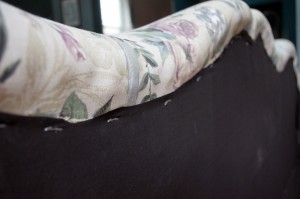Why Reupholster a Couch? Top 5 Reasons

 Perhaps you’re looking at your couch – the most noticeable piece of furniture in the room – and you’re not 100% pleased with what you see. It might be some obvious problem, such as a stain, or it might be something subtle, like slight fading. Perhaps you like the way it looks, but not the way it feels. Maybe you’re just feeling a strong urge to refresh your living space, and a new color or pattern on that big, shapely piece of furniture is the solution you need.
Perhaps you’re looking at your couch – the most noticeable piece of furniture in the room – and you’re not 100% pleased with what you see. It might be some obvious problem, such as a stain, or it might be something subtle, like slight fading. Perhaps you like the way it looks, but not the way it feels. Maybe you’re just feeling a strong urge to refresh your living space, and a new color or pattern on that big, shapely piece of furniture is the solution you need.
An experienced furniture repair-person would tell you that there are simpler jobs than couch reupholstery. To reupholster a couch effectively, it’s necessary to follow a logical procedure, pay attention to accurate measuring and type of fabric, know your tools, and to finish the job with detailing like welting and button-tufting. Depending on the sofa’s design, this could be simple or tricky, but won’t be as easy as re-covering a chair seat or making a new pillow cover.
There’s also the issue of cost. The skilled do-it-yourselfer who’s confident about re-covering his or her couch will save money. However, those who hire a competent upholsterer will also save, as compared to tossing out the unsatisfactory couch and buying a new one.
Reupholster a Couch: Transforming Your Furniture with Style
So, assess your sofa situation objectively. Here are five situations that call for reupholstering. Transform your space with DR. Sofa’s exquisite custom-made furniture, tailored to your unique style and comfort needs. Elevate your home today!
1. Physical damage to upholstery and/or supports. Damage can be caused by anything from a playful kitten to a crew of sports-lovers getting super-enthusiastic while watching a game! A sudden sag indicates likely damage to springs or webbing, as well as to the covering. Reupholstering can include “infrastructure” as well as exterior renewal.
2. Odors. Pet and child accidents, spilled food and drink, molds, and mildew are all causes of indelible smells. If they aren’t eliminated by surface cleaning or enzymatic odor-removers, the odor-causing chemicals have most likely penetrated the batting. At least partial reupholstering is required in this scenario.
3. A custom made sofa that’s no longer satisfactory. Custom made pieces are even more of an investment than standard ones, and you’ll be justifiably hesitant to throw one out because you want a change. But if you do want that change, reupholstery can solve your dilemma.
4. Fading. Sofa coverings, fabric or leather, react to light. Sunlight beating down on fabric will fade the color over time, and has an even more marked effect on the color and texture of leather. Depending on other factors, faded leather may be able to be re-colored and re-conditioned, but faded cloth must be replaced.
5. Dissatisfaction with the current fabric. Say you used to love deep walnut browns, but now you gravitate toward abstract prints. You have an increasingly active toddler, and foresee that a less formal, more stain resistant fabric is advisable. You like the couch, but never felt quite comfortable with the texture of the covering. All these problems can be solved by DR. Sofa.










